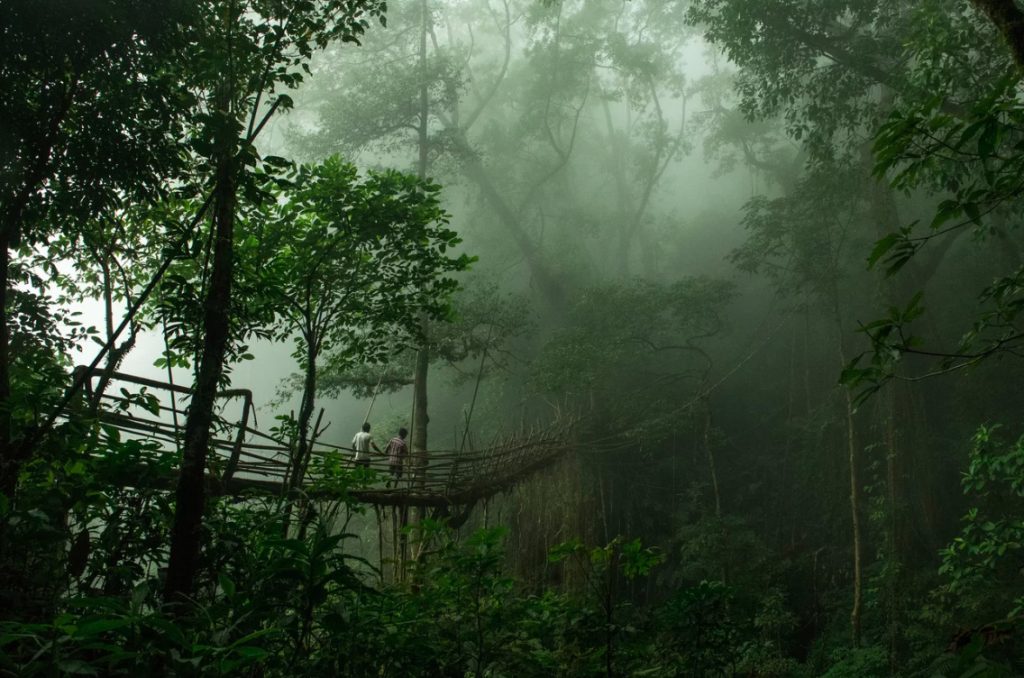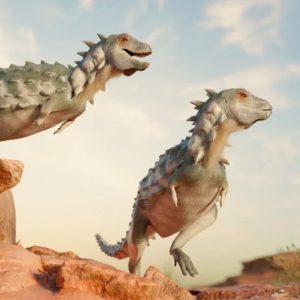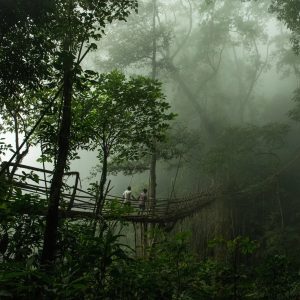Link About It: This Week’s Picks
Bacteria-based batteries, a new armored dinosaur, India’s forest bridges and more from around the web

A Battery Powered by Bacteria and Sweat
 Researchers from the University of Massachusetts Amherst have engineered a bacteria-based battery that can produce power from human sweat. The key to their innovation is bacterium Geobacter sulfurreducens, a bacteria that can produce electricity and has been used to explore microbial batteries. However, its need to be fed a constant diet has limited its functionality. To get around this, the researchers grew the bacteria sustainably in a biofilm, a consortium of microorganisms that grow on a surface, which provides nutrients to the bacteria so it can generate longterm energy. On the biofilm, the bacteria can convert energy from sweat evaporation into electricity with the goal of powering wearable electronics like medical sensors or personal gadgets. “It is real green energy,” says researcher Xiaomeng Liu, “and unlike other so-called ‘green-energy’ sources, its production is totally green.” Learn more about this at Digital Journal.
Researchers from the University of Massachusetts Amherst have engineered a bacteria-based battery that can produce power from human sweat. The key to their innovation is bacterium Geobacter sulfurreducens, a bacteria that can produce electricity and has been used to explore microbial batteries. However, its need to be fed a constant diet has limited its functionality. To get around this, the researchers grew the bacteria sustainably in a biofilm, a consortium of microorganisms that grow on a surface, which provides nutrients to the bacteria so it can generate longterm energy. On the biofilm, the bacteria can convert energy from sweat evaporation into electricity with the goal of powering wearable electronics like medical sensors or personal gadgets. “It is real green energy,” says researcher Xiaomeng Liu, “and unlike other so-called ‘green-energy’ sources, its production is totally green.” Learn more about this at Digital Journal.
Image courtesy of AFP
Food Forward Redirects 250 Million Pounds of Food from Landfills to Those in Need
Founded in 2009, LA-based non-profit Food Forward is celebrating a milestone achievement: redirecting 250 million pounds of food (about one billion servings) from landfills to communities facing food insecurity. This could not have happened without the organization’s nimble navigation of Southern California’s food distribution system. After saving fresh produce from predominately wholesale recovery programs, Food Forward stores it at their refrigerated Produce Pit Stop and then distributes it among several hunger relief programs that work in various parts of California, as well as six other states and two Tribal nations. Included in this list is the Cherokee Nation in Tahlequah, Oklahoma, a place that is home to the largest number of native Cherokee speakers in the country and where most groceries can only be bought at dollar stores. As opposed to the government’s only large-scale food initiative, the now-defunct USDA Farmers to Family program (which was marred by issues, from waste management to lack of nutritious options), Food Forward’s achievements attest to how community-based infrastructure provides critical care. Learn more about this at Civil Eats.
Image courtesy of Vanessa Bly
Fossils of Previously Unknown Dinosaur Discovered
 Researchers have found the fossils of a previously unknown dinosaur—named the Jakapil kaniukura—in the La Buitrera palaeontological zone in Patagonia’s Río Negro province. The dinosaur existed during the Cretaceous period (between 145.5 and 65.5 million years ago) and would have been well-protected thanks to disc-shaped armor covering its neck, back and tail. Its armored body means it belonged to the thyreophoran dinosaur group which also includes the “the bony backed, spiky tailed Stegosaurus and the tank-like Ankylosaurus.” The bipedal dinosaur was about five feet in length and walked using its rear two legs. Astonishingly, each Jakapil kaniukura weighed about the same as a house cat. Find out more at Popular Science.
Researchers have found the fossils of a previously unknown dinosaur—named the Jakapil kaniukura—in the La Buitrera palaeontological zone in Patagonia’s Río Negro province. The dinosaur existed during the Cretaceous period (between 145.5 and 65.5 million years ago) and would have been well-protected thanks to disc-shaped armor covering its neck, back and tail. Its armored body means it belonged to the thyreophoran dinosaur group which also includes the “the bony backed, spiky tailed Stegosaurus and the tank-like Ankylosaurus.” The bipedal dinosaur was about five feet in length and walked using its rear two legs. Astonishingly, each Jakapil kaniukura weighed about the same as a house cat. Find out more at Popular Science.
Image courtesy of Mauricio Álvarez and Gabriel Díaz Yanten
India’s Enchanting Living Bridges
 Flooding rivers, vast mountains and scattered villages characterize Meghalaya, the northeastern state of India considered one of the wettest regions in the world. For centuries, the Khasi people have learned to navigate this challenging terrain by creating living root bridges called jing kieng jri. Like something out of a fairytale, the bridges are feats of nature, innovation and architecture. They are crafted from rubber tree figs (aka Ficus elastica), planted on either side of a river. After 10 to 15 years, they produce aerial roots, which the locals coax across the river using bamboo scaffolding. As the trees continue to grow, the builders weave the roots to the other until they merge together via anastomosis. The natural process means each bridge is unique, grows stronger with age and adds to the environment’s ecosystem. “My mind was buzzing with thoughts of how much knowledge these bridges hold—for engineers, architects, ecologists, anthropologists and others. They are living, breathing examples of life in the past that can help us create sustainable lifestyles for the future,” says photographer and journalist Prasenjeet Yadav at NPR, where you can view and learn more about the bridges.
Flooding rivers, vast mountains and scattered villages characterize Meghalaya, the northeastern state of India considered one of the wettest regions in the world. For centuries, the Khasi people have learned to navigate this challenging terrain by creating living root bridges called jing kieng jri. Like something out of a fairytale, the bridges are feats of nature, innovation and architecture. They are crafted from rubber tree figs (aka Ficus elastica), planted on either side of a river. After 10 to 15 years, they produce aerial roots, which the locals coax across the river using bamboo scaffolding. As the trees continue to grow, the builders weave the roots to the other until they merge together via anastomosis. The natural process means each bridge is unique, grows stronger with age and adds to the environment’s ecosystem. “My mind was buzzing with thoughts of how much knowledge these bridges hold—for engineers, architects, ecologists, anthropologists and others. They are living, breathing examples of life in the past that can help us create sustainable lifestyles for the future,” says photographer and journalist Prasenjeet Yadav at NPR, where you can view and learn more about the bridges.
Image courtesy of Prasenjeet Yadav
Study Discredits “Social Contagion” Among Trans Kids
 As legislative efforts to strip trans people of life-affirming healthcare continue, bolstered by disinformation, researchers have found that the theory of “social contagion” causing gender dysphoria in trans kids is not credible. The study—led by Boston-based Fenway Institute—was published in the journal Pediatrics and disproves the concept of “rapid-onset gender dysphoria” (not a formal mental health term or diagnosis) and explains that kids coming out as trans are not just doing so because their friends are. This might seem obvious, but many conservative thinkers commonly disbelieve kids when they tell us who they are—even when it takes courage and might subject them to bullying. “The idea that attempts to flee sexual minority stigma drive teenagers to come out as transgender is absurd, especially to those of us who provide treatment to [transgender and gender diverse] youth,” says Dr Jack Turbam, an incoming assistant professor of child and adolescent psychiatry at the University of California, San Francisco, and the lead author of the study. Read more at NBC News.
As legislative efforts to strip trans people of life-affirming healthcare continue, bolstered by disinformation, researchers have found that the theory of “social contagion” causing gender dysphoria in trans kids is not credible. The study—led by Boston-based Fenway Institute—was published in the journal Pediatrics and disproves the concept of “rapid-onset gender dysphoria” (not a formal mental health term or diagnosis) and explains that kids coming out as trans are not just doing so because their friends are. This might seem obvious, but many conservative thinkers commonly disbelieve kids when they tell us who they are—even when it takes courage and might subject them to bullying. “The idea that attempts to flee sexual minority stigma drive teenagers to come out as transgender is absurd, especially to those of us who provide treatment to [transgender and gender diverse] youth,” says Dr Jack Turbam, an incoming assistant professor of child and adolescent psychiatry at the University of California, San Francisco, and the lead author of the study. Read more at NBC News.
Image courtesy of Erik McGregor/LightRocket/Getty Images
The World’s First All-Electric RV, The Bowlus Volterra
 Merging Scandinavian design, luxury and sustainability, California-based Bowlus has just launched the Volterra: the world’s first all-electric RV that can be kept off the grid entirely, thanks to solar-powered energy. Its electricity stems from AeroSolar, a lightweight yet efficient system that charges the RV while it’s being driven, absorbing up to 480 watts of energy and providing 65 miles of EV charging. It also powers Volterra’s sophisticated amenities like heated floors and high-speed internet. Surplus energy can even be transferred to other EVs. Priced at $310,000, the sleek RV can double as additional living space, as its spa-like ensuite, timber flooring and linen textiles provide comfortability as well as privacy. Learn more about the exciting vehicle at Dwell.
Merging Scandinavian design, luxury and sustainability, California-based Bowlus has just launched the Volterra: the world’s first all-electric RV that can be kept off the grid entirely, thanks to solar-powered energy. Its electricity stems from AeroSolar, a lightweight yet efficient system that charges the RV while it’s being driven, absorbing up to 480 watts of energy and providing 65 miles of EV charging. It also powers Volterra’s sophisticated amenities like heated floors and high-speed internet. Surplus energy can even be transferred to other EVs. Priced at $310,000, the sleek RV can double as additional living space, as its spa-like ensuite, timber flooring and linen textiles provide comfortability as well as privacy. Learn more about the exciting vehicle at Dwell.
Image courtesy of Bowlus
Link About It is our filtered look at the web, shared daily in Link and on social media, and rounded up every Saturday morning. Hero image courtesy of Prasenjeet Yadav












